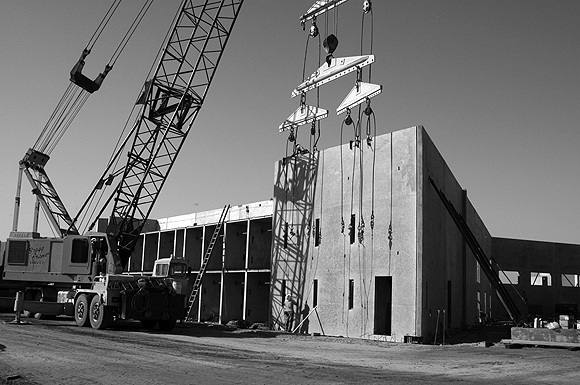
Between 1983 and 2003, California built 23 new prisons and just one new university. California raised prison guard salaries above teacher salaries, but cut academic and vocational training for prison inmates. Prisons, the antithesis of schools, seem to be in the future for more and more Californians. While this prospect is deeply disturbing, architects are in a unique position to help reverse it.
Architects / Designers / Planners for Social Responsibility (ADPSR) calls on architects to boycott the design of prisons. The way we see it, our current pattern of investing in prisons creates a dead-end future. Prisons take valuable resources we need for other priorities, reward corrupt interest groups, and return brutalized individuals with few prospects to our communities. The more we build prisons, the more we anticipate a future of increased violent crime, racial division, and suffering. Architects are essential to envisioning more positive alternatives, and we must take an active role in advocacy to realize them.

Why are prisons so bad? First, prisons take away needed resources from the kind of educational and development programs California (and other states) need but cannot afford. During the 2003 bud get crisis, while California’s K-12 and higher education budgets were cut, corrections was the only area proposed for an increase. Nationally, from 1977 to 1999, spending on corrections increased about 2.5 times the rate of increase of spending on all levels of education, and California spent $5.3 billion on prison construction. Currently, we spend $4.8 billion per year on prison operations. We clearly cannot afford both the corrections system we have and the education system we would like.
Second, building prisons increases the number of people in jail, irrespective of the demands of justice. The U.S. now has a prison population over 2 million (160,000 in California, second only to Texas), and more prisoners per capita than any country in the world; however, our crime rate has lowered to 1970s levels. Why do we have so many people in prison? Politicians have criminalized new activities and increased sentences in response to a climate of fear, eloquently described in Michael Moore’s film Bowling for Columbine. But mass imprisonment also benefits some sectors of the economy. The California Correctional Peace Officers Association, or prison guards’ union, is the largest contributor to California political campaigns. Private prison operation companies build and operate speculative prisons, making profit on a per-prisoner basis. Many powerful financial interests in the “prison-industrial complex” are deeply invested in locking up more people, regardless of whether crime increases or, as has happened lately, decreases.
Third, new prisons send a bad message to our society, especially to those who are most vulnerable. Children in low-income neighborhoods may not have toilet paper or textbooks in their school, or may learn in decrepit thirty-year old portable classrooms, but many know there’s a space for them in prison. In 1997, the federal Bureau of Justice Statistics estimated that an average African-American man had a higher chance of going to prison than getting a bachelor’s degree.
Prisons in many ways are the mirror opposites of schools. Schools embody our hope that people will improve themselves and their communities. Prisons destroy that hope and tear apart the communities that prisoners come from. Through the routine use of violence, enforced work at skill-less jobs, and lack of rehabilitation (and support upon release), prisons teach prisoners how to fail in society, show that violence is the most important survival skill, and prepare prisoners to re-offend. In a way, California’s prison system is a vast criminal university, which makes us all less safe.
ADPSR knows architecture as a profession of optimism, and architects as those who strive to make the world better through design. Our profession is enthusiastic about designing schools because of the great opportunity to help others and directly improve our society. Prisons are the antithesis of these professional aspirations, just as they are, in many ways, the antithesis of schools: prisons realize a drastically pessimistic view of society, and actively make individuals and society worse. Many groups from Quakers to teachers to ex-convicts are opposed to the prison-industrial complex, but few architects are aware of the scale of the problem our prison system has created. By speaking out as a profession, architects can add a major voice to the growing chorus demanding change in our legal and penal systems and end the prison epidemic. We encourage you to join our campaign to raise awareness of this issue and pledge not to design prisons at www.adpsr.org/prisons.
Author Raphael Sperry is national President of Architects / Designers / Planners for Social Responsibility (ADPSR) and works at 450 Architects in San Francisco. ADPSR is a national educational non-profit working for peace, environmental protection, ecological building, social justice, and development of healthy communities. For more information, visit www.adpsr.org.
Originally published in 4th quarter 2004, in arcCA 04.4, “School Daze.”





